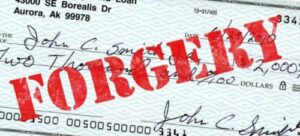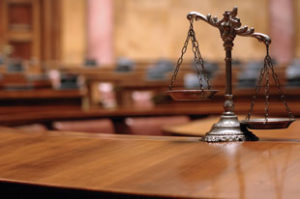 Forgery is more than someone merely signing, without permission, the name of someone else on a document. Forgery includes, thanks to modern technology, the imposition or transfer of an electronic image of a person’s signature from one document to another. Forgery, also, at least based upon our definition includes the alteration of a signed document, such that the document has been rendered inauthentic and not what it purports to be.
Forgery is more than someone merely signing, without permission, the name of someone else on a document. Forgery includes, thanks to modern technology, the imposition or transfer of an electronic image of a person’s signature from one document to another. Forgery, also, at least based upon our definition includes the alteration of a signed document, such that the document has been rendered inauthentic and not what it purports to be.
New account forms have been the subject of forgery. New account forms actually signed by the customer but later completed with false information by the stockbroker, are altered documents, and by our definition are forgeries or a sub-species of forgery. Risk disclosure documents have been the subject of forgery. “Free look” and other documents associated with the purchase of variable annuities have been the subject of forgeries.
However, the most common form of forgery, or at least the one that causes investors the most harm are forged letters of authorization used to make the unauthorized removal of funds from customer accounts by third parties, and on certain occasions, in the case of stockbroker theft, the stockbroker.
Proving Forgery, Fraud, and The Alteration of Documents
Proving forgery is difficult. In order for a handwriting expert to render an opinion as to whether a document has been forged, the expert generally needs the original document, which is often unavailable. Even when the original is available, a handwriting expert can generally only opine or offer their testimony as to whether in their professional opinion the subject document was forged with a reasonable degree, or a high degree of certainty.
 Although the Federal Rules of Evidence purportedly do not apply in FINRA securities arbitration according to Rule 12604 of the Code of Arbitration Procedure, they offer guidance on many issues of the admissibility of certain evidence. Rule 901 (b)(2) of the Federal Rules of Evidence, with respect to handwriting provides that: for purposes of admissibility or authenticity evidence may consist of a ‘nonexpert’s opinion that handwriting is genuine, based on a familiarity with it that was not acquired for the current litigation.”
Although the Federal Rules of Evidence purportedly do not apply in FINRA securities arbitration according to Rule 12604 of the Code of Arbitration Procedure, they offer guidance on many issues of the admissibility of certain evidence. Rule 901 (b)(2) of the Federal Rules of Evidence, with respect to handwriting provides that: for purposes of admissibility or authenticity evidence may consist of a ‘nonexpert’s opinion that handwriting is genuine, based on a familiarity with it that was not acquired for the current litigation.”
FINRA also suggests that a firm’s policies and procedures should include procedures that are reasonably designed to, verify and compare with other documents signed by the customer the authorization for the removal of funds from investor accounts has been executed by the customer. Regulatory Notice 09-64.
If you suspect that you have been the victim of forgery and have suffered economic damages as a result, including the theft of funds, you should consult with an attorney immediately. Irrespective of state law or the provisions of the Uniform Commercial Code, where customers are required to report theft or discrepancies with respect to their account in a very short period of time, sometimes sixty to ninety days, investors have a responsibility to review their monthly customer statements. Customers also have a duty to review their account verification profile, or a copy or confirmation of the information contained on their new account form, and if the stockbroker filled out this information or altered the documents after the form was signed, the customer needs to take action.
The Guiliano Law Group
The Guiliano Law Group has extensive experience in FINRA securities arbitrations involving forgery, or where forgery or the alteration of documents has been a material issue. We offer our services on a contingent fee basis, and do not get paid unless we make a recovery for you. For a confidential, no obligation evaluation of your claim, contact us or call us at (877) SEC-ATTY
